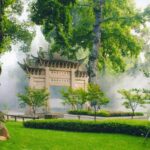Yongqing Temple was established in the second year of Emperor Wu of Liang’s Datong era (AD 536), and it was a prominent Buddhist site during the Southern Dynasties, governing dozens of temples along the river and holding a high status in the Buddhist community. Over thousands of years, Yongqing Temple experienced several periods of prosperity and decline, was destroyed in 1958, and was reconstructed and reopened for Buddhist activities in August 1993. The current Yongqing Temple complex primarily features the mountain gate, Jialan Hall, the Release-Life Pond, the Mahavira Hall, and the Jade Buddha Hall among other attractions. Inside the temple, the Arhat Hall houses 16 statues of Arhats, which were personally sculpted by the Tang Dynasty sculptor Yang Huizhi. The temple and its surroundings boast numerous historical sites, including the ‘three wonders’: a thousand-year-old cypress, a flesh body bodhisattva, and a natural stone well. Surrounded by beautiful scenery, Yongqing Temple has been a popular destination for scholars and literati throughout the ages, leaving behind hundreds of poems and verses. Dozens of literati, including Yang Weizhen, Shi Nai’an, Xu Chongcheng, Yuan Cheng, and Zhao Zaigong, have visited the temple. Shi Nai’an once secluded himself in the Wenchang Pavilion of the temple to write, leaving behind relics such as the ink-washing pond, sword-grinding stone, and his clothes and hat. In the twelfth year of the Tianbao era of the Tang Dynasty (AD 754), the eminent monk Jianzhen, on his last voyage to Japan, visited the temple at the invitation of the abbot Changda before departing from Huangsipu to sail to Japan. The temple is open year-round from 7:00 to 16:00.
Preferential policies additional information:
1. Free admission policy:
1. Children under 6 years old (inclusive) or under 1.4 meters (inclusive) in height with valid identification are admitted for free.
2. Elderly people aged 70 and above (inclusive) with valid identification are admitted for free.
3. Active-duty military personnel and retired military officers of the People’s Republic of China with valid identification are admitted for free.
4. People with disabilities and one accompanying caregiver for severely disabled individuals with valid identification are admitted for free.
2. Discount policy:
1. Minors aged 6 years (exclusive) to 18 years (inclusive) with valid identification enjoy half-price admission.
2. Full-time undergraduate and below students with valid identification enjoy half-price admission.
3. Elderly people aged 60 to 70 (inclusive of 60, exclusive of 70) with valid identification enjoy half-price admission.
10. The above information is for reference only; please refer to the official announcement of the scenic area for details.
Yongqing Temple at Fenghuang Mountain Scenic Area
Yongqing Temple was established in the second year of Emperor Wu of Liang’s Datong era (AD 536[...]









